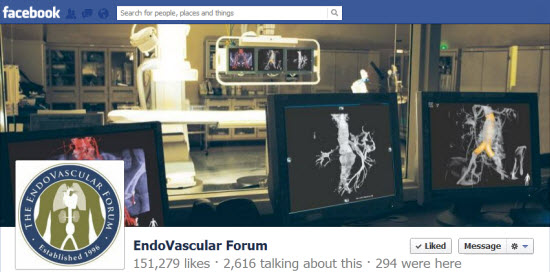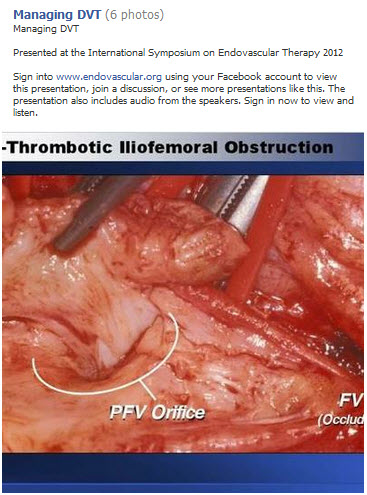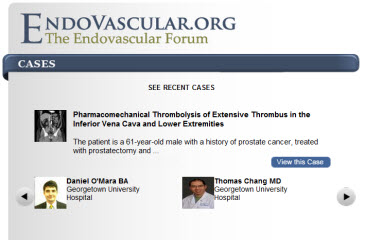|
like
2 comments
share |
8 min reading time
It’s unbelievable, really. I haven’t seen ANYONE successfully use Facebook in a Business-to-Business (B2B) application. Until now. Enter Rony Sellam, the Chief Strategy Officer for the Endovascular Forum (EVF). Rony Sellam: Thanks for having me on #MedDevice, @MedicalMarcom. Joe Hage: Rony, we’ve known one another (virtually) for a while. It’s good to have a chance to chat. I invited you today because I’m especially impressed with what you built at the Endovascular Forum. Please tell my readers about it. Rony Sellam: The Endovascular Forum has been around since 1996, and really has been a learning platform for endovascular specialists to learn from one another across specialties and across borders.
Rony Sellam: We can’t completely believe it, either, and frankly got pretty surprised early on at how much interest we saw our initial assumption was that a pro network such as Linkedin would be more conducive to driving MD usage but soon realized that FB is indeed being used by physicians, nurses, techs, and med device pros as well. Rony Sellam: And I understand when you post something, you get quite a bit of engagement.
Joe Hage: Wow. Wow. And Wow. Do they leave comments as well? This particular post is at six comments so far. Most of the comments are congratulatory. The posts that are didactic (funny aside) in nature usually get “Great” and the likes. But posts controversial in nature or require thinking can easily get in the hundreds of comments. And the average post will in general reach 20,000+ people. Joe Hage: So tell us, HOW did you get such a large Facebook following? Do you advertise on Facebook? Rony Sellam: Well, we do advertise but as you probably know, that’s far from being enough to get earned media AND keep it. We think of our FB followers as having a social contract with us; they expect top-notch content that teaches them how to be better at treating patients. So, we simply make sure that everything we EVER communicate to them achieves that end. Zero tolerance for anything else. We also spend a lot of time listening. As you know, Linkedin does not provide you enough analytics … Joe Hage: Believe me, I know it! Rony Sellam: … to truly understand what your audience wants more of (or less of); I think FB is excellent at it, and if you know how to truly listen, you can really improve yourself over time. It’s really about tweaking.
We also (with our audience) need to adapt to their specialty and sub-specialty; some of our content is purely endovascular (inside the vessel) and about image-based medicine, and some of it is surgical in nature. This reflects the evolution of our audience. To illustrate, vascular surgeons a few years ago were not spending a lot of their time treating patients minimally invasively. They now are, so we have a very sizable portion of our audience that now comes from surgical specialties. We also have devices being used in some countries and not in others, and you can really see how the availability of medical technology has a profound influence on how physicians approach treatment. Joe Hage: You said so many interesting things in there I hardly know where to start! I’m really interested in the change in media: From videos “working” to still images. Any ideas why? Rony Sellam: My assumption is that physicians are increasingly consuming content on mobile devices, where video is less convenient. I also believe it has to do with control; when you watch a video you are passive; when you flip through images, you decide on the pace and amount of time you dedicate to each element of the content.
Rony Sellam: We are seeing the same trend; we continue to serve video but are giving more presence to still albums and snackable text. Joe Hage: And I imagine, for topics like yours, you have generous and illustrative captions for each, yes? Rony Sellam: Yes, we do. When going through a clinical case, for example, there is a minimum of info that needs to be provided about the patient history & diagnosis, the treatment approach, and the results of the intervention. Joe Hage: Some of my readers won’t understand what you meant, “That’s far from being enough to get earned media AND keep it.” Rony Sellam: Earned media is, for example, a “like” or a comment from a member of your audience. In effect, the audience has the ability to take control of your brand. What I mean is that any content you broadcast can be “lifted” by an individual and augmented by their views or comments. This means two things:
Rony Sellam: Adapt the marcom infrastructure (fundamental organizational plumbing) to a new reality so it can be embraced. Tactically, this means that a tighter partnership needs to be created between Legal/Regulatory and the marketing organization, and that procedures are put in place to control and manage an additional and incredibly powerful “listening device.” Most manufacturers are interested in listening to their customers, especially if they believe they have a superior product. The fear of the unknown is still part of the equation at this point, but many companies are running pilots with social platforms, and laying down new foundations; they are partially driven by the economic realities of their business (getting squeezed), and the fact that social media platforms are incredibly efficient to engage, listen, and broadcast high quality information. One illustration: Two years ago, it took me two hours, and a lot of effort to publish an iPad-friendly clinical case on video. It required engineering and visual designer support. Today, on the Endovascular Forum, I can do it – myself – in less than a minute. This kind of efficiency is absolutely impossible to ignore when you have limited marketing dollars.
Joe Hage: For some, that’s a lot to swallow. Social is terribly time-consuming and then they say, “Where’s my return?” The potentially unfortunate answer is, “The interruption marketing you used to do, simply isn’t as accepted anymore.” “We have a new reality. Adapt or die.” Rony Sellam: They see social media as a line item on an EXCEL spreadsheet. Joe Hage: We can argue the merits of “conversing.” Still, they do have a point. Social media is “a line item.” Rony Sellam: The other items are currently “newsletter,” “corp website,” etc. A more relevant list would be “Market sizing,” “Upstream mktg,” “Sales force training,” “KOL meetings ….” These are the true large cost items that traditionally require significant resources and that can genuinely be replaced or at least accelerated through technology. And, by the way, you can’t afford a $100K meeting of key opinion leaders today, the way you were able to 10 years ago. You must find other ways to listen and gather quality market intelligence. Joe Hage: That’s a really interesting comparison: Online conversation with key opinion leaders versus the trade show booth / conference.
Rony Sellam: There is a new customer out there; he is faster, more difficult to get to (no $200 dinners any more), is bombarded with info and somehow your job as a marketer is to do a lot more with this new customer, with a lot less resources. This creates a dissonance in the market, and is what is also driving the change imperative; hence pilots galore on new approaches. In my view, the approaches that come from senior execs connected to L&R have the most potential for success.
Joe Hage: So HR will have to import talent from other industries people who understand online. It’s my basic value proposition, in fact. I think mine is a relatively narrow niche: A medical device guy who understands contemporary online marketing and lead generation. Rony Sellam: Yes, it’s rare. The bottom line is (New customer) + (Less budget) cannot equal same old tricks of the trade; certainly not for market or segment leaders. Joe Hage: Let’s change subjects. You have a captive audience of endovascular physicians. How can a medical device manufacturer take advantage of this? Advertising on your site? Rony Sellam: Well, we have ways to accomplish traditional goals with markedly lower effort required. With the understanding that providing security, privacy, and control are key attributes. Virtual KOL meeting rooms, showcase clinical cases, and structured conversations are some examples of what companies can invite our audience to participate in. We just launched an App Exchange platform on the EVF which allows a physician user to construct the feeds and interests they want to see on the Forum. Part of our users’ interests definitely is med device and technology related. They want to know what your company is doing to improve a device or therapeutic approach. Joe Hage: So there are opportunities for medical device companies to get in front of your audience. Rony Sellam: Absolutely. They can see 2,000 physicians just subscribed to their EVF App. They can be informed of the progress they’re are making. They can see actual users’ reviews of their devices actually used in a case. Users walk through their cases right on the Forum. It’s a lot less about basic branding and a lot more about developing a conversation around your company and technology. For this to work, you need three things: (1) a large audience, (2) an engaging topic, and (3) the tools for the conversation to happen without friction (loss of productivity). We offer all three. The power of our platform comes from the fact that physicians are given a voice; whether they be representing a manufacturer’s views (with appropriate disclosures) or the views of their customer base. Joe Hage: Rony, thanks so much for your time and insights.
Rony Sellam: In particular, our audience is interested in future product launches from innovative companies for treating vascular/cardiovascular disease. Great conversation. Thank you for having me. Saif Anwar First of all, this was a great read. Thanks! Rony and Joe, are there any forums designed for Physicians that can comment or list about technologies that they would like to see get implemented in the hospitals that would facilitate patient care-giving in the years to come? Thanks, Tracy zhang Marked as spam
|
Meet your next client here. Join our medical devices group community.
We still use LinkedIn to access our site because it’s the only way to “pull in” your LinkedIn photo, name, and hyperlink to your profile page, all vital in building your professional network. When you log in using LinkedIn, you are giving LinkedIn your password, not me. I never see nor store your LinkedIn credentials.





 Rony Sellam: Our last post, “
Rony Sellam: Our last post, “
 Joe Hage: Are you making that video-to-still image shift on the Forum itself, as well?
Joe Hage: Are you making that video-to-still image shift on the Forum itself, as well?




